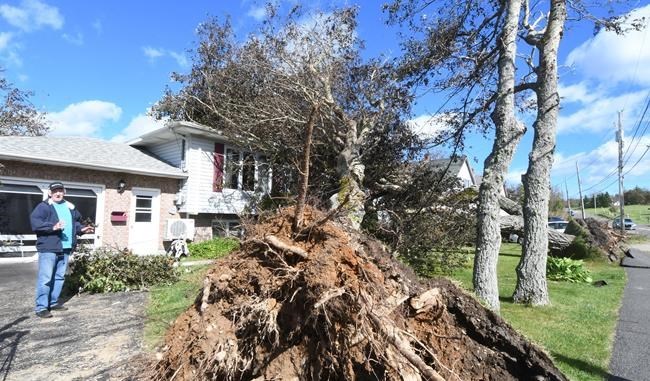STANLEY BRIDGE, P.E.I. — Phyllis Carr's voice broke with emotion as she surveyed damage to the historic town of Stanley Bridge, a small community on the north shore of Prince Edward Island.
"It's very sad for those of us who lived here all of our lives and our parents lived here," she said, taking in a scene that has become all too familiar in towns and villages across Atlantic Canada battered and drenched by post-tropical storm Fiona.
"Our life is going to change now around our harbour, and our marina and our fishing community and our fishermen."
By the time Fiona left Stanley Bridge on Saturday, the main road was washed out, debris was strewn everywhere and the town's prospects had suddenly dimmed, mainly because of damage to fishing boats that were picked up by a storm surge and dropped in the middle of the road.
Across the Maritimes, eastern Quebec and in southwestern Newfoundland, the economic impact of the storm's wrath is still being tallied.
And electricity has yet to be restored to about 250,000 homes and businesses in Atlantic Canada. At the height of the storm on Saturday, more than 500,000 were in the dark, including 80 per cent of Nova Scotia Power's customers and 90 per cent of P.E.I.
Even as crews worked around the clock to repair downed lines, some utility companies warned it could be several days before the power is back on for everyone.
"We’ve been able to start getting a better look at some of those hardest-hit areas with drones and helicopters and it is reinforcing how widespread the damage is," Matt Drover, a spokesman for Nova Scotia Power, said in a statement Monday.
Drover said the utility is having to deal with thousands of trees on power lines, hundreds of broken or leaning poles and streets blocked by debris. He said the company has dispatched more than 1,000 technicians to the field, including crews from New Brunswick, Quebec, Ontario and New England.
Police in Nova Scotia said Monday that a man missing since Friday is believed to have been swept out to sea during the storm. Halifax district RCMP said 81-year-old Larry Smith of Lower Prospect, N.S., was last seen Friday evening, and an exhaustive search turned up no trace of him.
Search efforts were called off "based on the belief Mr. Smith entered the water," the RCMP said in a statement.
On Sunday, RCMP in western Newfoundland confirmed that the body of a 73-year-old woman from Port aux Basques had been recovered after a record-breaking storm surge flooded her home and swept her out to sea. Her name was not released. The cause of death in another possible Fiona-related fatality in P.E.I. has yet to be determined, but the province's acting director of public safety said Sunday preliminary findings pointed toward "generator use.''
Prime Minister Justin Trudeau expressed his condolences to the woman's family during a media briefing in Ottawa. He said he plans to visit the region this week.
During the briefing, Newfoundland MP Gudie Hutchings told the prime minister that the gut-wrenching photos from Port aux Basques do not convey the level of devastation. She said at least 76 homes in the town of 4,000 had either been destroyed or structurally damaged.
"Newfoundlanders and Labradorians are resilient people, but I can tell you this has tested each and every one of us," she said via video link from Port aux Basques. "(But) everyone is coming together to help these folks in need."
Rene Roy, editor of the town's weekly newspaper, said the community remains in shock.
"There’s a lot of absolute uncertainty and shocked faces," the editor of the Wreckhouse Press said in an interview Monday. "Normally when you walk around this town … people give you a nod, a smile or a wave. Today and yesterday, it's just a shake of the head and click of the tongue.”
The southwestern corner of Newfoundland is used to major storms, Roy said, but Fiona's lashing was unlike anything the community had ever seen.
"For the first time ever, everyone in town feared for their own life," he said. “Now, we have 200 people without a place to stay."
Earlier in the day, Defence Minister Anita Anand confirmed that HMCS Margaret Brooke, one of the military's new Arctic patrol ships, will be conducting wellness checks in small communities along the southern shore of Newfoundland.
Meanwhile, members of the Canadian Armed Forces are being deployed to help with the cleanup. Anand confirmed Sunday that Newfoundland, Nova Scotia and P.E.I. would each be getting about 100 soldiers, with some already in place.
Asked whether 100 soldiers per province was enough considering the scale of the devastation, Trudeau said: "If they need more, we will send more."
The prime minister was also asked about past promises to improve the resilience of telecommunications infrastructure after cellphone service was severely affected by post-tropical storm Dorian in 2019. Trudeau said the government worked with providers before Fiona hit, but the storm exceeded even the direst predictions.
"We have learned lessons since Dorian and implemented them," he said. "There will be more to learn on how we keep people protected, given that extreme weather events are going to get, unfortunately, more likely in the coming years."
In Sydney, Cape Breton's largest city, dozens of people — many of them international students or workers from Asia — have sought temporary shelter at the Membertou First Nation's trade and convention centre.
Most of them were forced to flee an apartment building that started leaking when Fiona unleashed heavy downpours and tore at the building's roof.
"Suddenly, emergency teams told us to evacuate the building," said Deepchand Kumar Medalodan, a 30-year-old hospital worker who attended Cape Breton University. "We just grabbed essentials like passports and wallets."
Medalodan said finding a new place to live will be tough. "There are a lot of students coming here and there aren't apartments here."
This report by The Canadian Press was first published Sept. 26, 2022.
— With files from Michael MacDonald and Lyndsay Armstrong in Halifax, Michael Tutton in Sydney, N.S., Lee Berthiaume in Ottawa and Morgan Lowrie in Montreal.
Hina Alam, The Canadian Press




